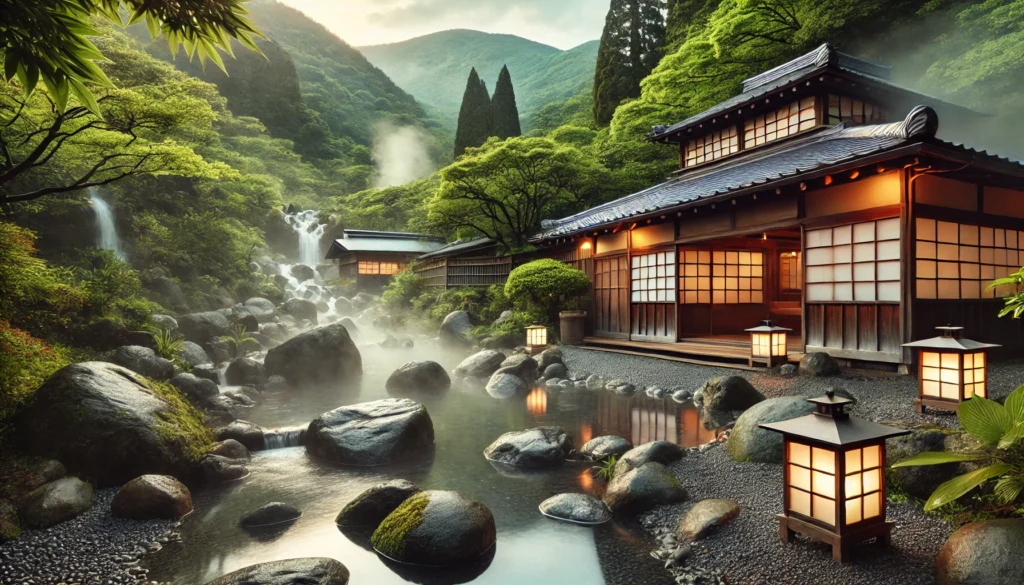Table of Contents
Introduction to Onsen Culture in Japan
The term ‘onsen’ refers to naturally occurring hot springs found throughout Japan, a country renowned for its volcanic activity. Historically, these hot springs have played a pivotal role in Japanese society, dating back to ancient times when they were first discovered for their therapeutic properties. As per traditional beliefs, onsen bathing was not only a means of relaxation but also a spiritual ritual, believed to purify the body and mind. This practice has evolved into an integral part of Japanese culture, combining elements of leisure, health, and community.
There are various types of onsen, categorized based on their mineral content, temperature, and geographical location. From the picturesque mountainous areas to coastal regions, Japan offers a diverse range of onsen experiences. Common varieties include sulfuric, sodium bicarbonate, and carbonated springs, each boasting unique health benefits. The experience of visiting an onsen typically involves enjoying both indoor and outdoor baths, often surrounded by breathtaking nature, which enhances the soothing effect of the warm waters.
Onsen culture in Japan extends beyond mere bathing; it embodies social interaction and community bonding. Many ryokans, or traditional inns, offer onsen facilities, encouraging guests to unwind and connect with one another. The Japanese emphasize etiquette and respect for the onsen environment, noting the importance of rinsing off before entering the communal baths and maintaining silence to foster a calming atmosphere.
The health benefits associated with onsen bathing are numerous, including relaxation, improved circulation, and skin health. The minerals present in the water are believed to alleviate various ailments, from muscle pain to skin conditions. As such, onsen experiences serve both a recreational and therapeutic purpose for individuals seeking to rejuvenate their physical and mental well-being. This unique blend of tradition and health continues to captivate both local residents and tourists alike, making onsen a quintessential aspect of Japanese life.

Top Onsen Regions in Japan
Japan is renowned for its rich onsen culture, with various regions offering unique hot spring experiences. Among the most famous onsen destinations is Hakone, located just a short train ride from Tokyo. Nestled in the mountainous landscape, Hakone is known not only for its hot springs but also for stunning views of Mount Fuji. Visitors can enjoy a variety of onsen options, from traditional ryokans to outdoor baths with picturesque surroundings. The accessible transportation, including the Hakone Free Pass, makes it easy for travelers to explore the area and experience multiple onsen resorts in a single visit.
Another prominent onsen region is Beppu, situated on the island of Kyushu. Beppu features a diverse range of hot springs, including mud baths, steam baths, and the famous “Hells of Beppu,” a collection of unique geothermal sites. This region is particularly well-known for its focus on wellness, with many facilities offering health treatments and picturesque onsen experiences. The hot spring water in Beppu is known for its high mineral content, contributing to skin benefits. Accessibility is convenient, as Beppu is serviced by a major railway station, attracting numerous visitors looking for a therapeutic escape.
Kinosaki, located in Hyogo Prefecture, stands out with its charming traditional atmosphere. Visitors can stroll along the picturesque streets wearing yukata, a casual summer kimono, and visit multiple onsen facilities known as “sotoyu.” Kinosaki is known for its seven public bathhouses, each with a distinct character and unique mineral compositions. The serene riverside experiences coupled with local attractions such as quaint shops and beautiful scenery enrich the visit. Accessible via train from major stations, Kinosaki offers an inviting onsen experience that highlights Japan’s cultural heritage.
Must-Visit Onsen: A Curated List
Japan boasts an impressive array of onsen, offering unique experiences that cater to various tastes and budgets. One noteworthy destination is the Hakone Onsen, a renowned hot spring resort situated near Tokyo. This onsen is celebrated for its breathtaking views of Mount Fuji and diverse bath options, including both indoor and outdoor onsen. Visitors can soak in natural thermal waters while enjoying the serene beauty of the surrounding landscape. Accommodations vary from luxury ryokans to budget-friendly hotels, ensuring that every traveler finds suitable lodging.
Another must-visit is the Kusatsu Onsen in Nagano Prefecture. Often referred to as one of Japan’s best onsen, Kusatsu is famed for its high-quality sulfuric waters, which are reputed for their healing properties. At the center of the town lies Yubatake (hot water field), where visitors can watch the steam rising from the hot spring water. Traditional bathhouses, such as Sainokawara Rotenburo, provide an authentic experience amidst stunning natural scenery. The town also features numerous dining options, specializing in local delicacies.
For those seeking a tranquil experience, Arima Onsen in Hyogo Prefecture is an excellent choice. Known for its historical significance, Arima offers both golden and silver waters, each distinct in its mineral content. This onsen has several public baths as well as ryokan accommodations that emphasize traditional Japanese hospitality. Visitors can wander through charming streets lined with gift shops and tea houses, creating a peaceful atmosphere conducive to relaxation.
Lastly, Noboribetsu Onsen on Hokkaido stands out for its dramatic landscapes and variety of mineral-rich springs. Popular baths here include the Hell Valley (Jigokudani) area, where sulfurous steam rises ominously. Noboribetsu offers various accommodation options, from luxurious hotels to budget-friendly stays, making it accessible for numerous visitors. This collection of onsen experiences highlights the diversity and beauty of Japan’s hot spring culture.
The Etiquette of Onsen Bathing
Visiting an onsen, or hot spring, is a cherished ritual in Japan that extends beyond mere relaxation; it is a culturally rich experience imbued with specific etiquette. Understanding how to navigate the dos and don’ts of onsen bathing is essential for first-time visitors seeking to partake in this unique tradition respectfully.
Before entering an onsen, it is prudent to prepare appropriately. This begins with showering thoroughly to cleanse the body. Cleanliness is paramount in onsen culture, as guests are required to wash themselves at designated stations using stools, hand-held showers, and provided soap before soaking in the communal baths. Not only does this uphold hygiene standards, but it also reflects respect for fellow bathers. It is advisable to refrain from bringing towels into the baths; rather, small towels can be used for modesty while showering, then left outside the pool area.
Once in the bathing area, there are crucial rules to observe. First, shared baths are typically nude; swimsuits are not permitted, as the onsen experience is meant to be a natural and unencumbered one. For those who may feel uncomfortable with nudity, many establishments offer private baths. While in the onsen, speaking in hushed tones is encouraged, as it preserves the serene ambiance that bathers seek. Additionally, avoid submerging towels in the hot spring water, as this can be seen as disrespectful to the communal space.
Lastly, it is essential to keep the onsen experience relaxed. Taking time to unwind and enjoy the atmosphere is part of the ritual. Being mindful of others, adhering to cleanliness, and respecting the local customs will enhance your onsen experience and make it an enriching part of your visit to Japan.
Different Types of Onsen: Fuji-san to Geothermal Springs
Japan is renowned for its diverse types of onsen, which are natural hot springs enriched with minerals from the earth, primarily due to the volcanic activity of the region. The country’s distinct geological features contribute to the variation in mineral content across different areas, making every onsen experience unique. From the iconic onsen at the foot of Mt. Fuji to the geothermal springs of Hokkaido, each location provides its own array of therapeutic benefits.
The different types of onsen can be broadly categorized based on their water sources and bathing facilities. Rotenburo, or outdoor baths, offer a serene experience immersed in nature, allowing visitors to enjoy stunning surroundings while relaxing in warm, nourishing water. These baths are often found in picturesque locations, enhancing the overall experience with scenic views, particularly in regions like Hakone and Beppu.
In addition to traditional baths, Japan hosts unique alternatives such as sand baths (sunaburo) commonly experienced in areas like Ibusuki. These provide a different form of therapy, where guests are buried in naturally heated volcanic sand — a treatment believed to promote relaxation and detoxification. Furthermore, foot baths (ashiyu), which can be found in many onsen towns, offer a convenient way to enjoy the restorative qualities of mineral-rich water without fully immersing oneself.
Scientific studies have highlighted the health benefits associated with various minerals commonly found in onsen water, such as sulfur, calcium, and magnesium. These minerals are known to improve skin conditions, relieve stress, and soothe muscle pain. Visitors are often encouraged to explore different types of water and their effects, making the experience both enjoyable and beneficial. Ultimately, the diversity of onsen types contributes to Japan’s rich cultural practice of onsen bathing, allowing individuals to choose a therapeutic experience that best suits their needs.
Combining Onsen with Local Activities
Visiting an onsen, or Japanese hot spring, offers a unique experience that can be considerably enhanced by integrating local activities and attractions into your itinerary. Japan boasts a rich cultural heritage and stunning natural landscapes, presenting plentiful opportunities for exploration. By planning additional activities alongside your onsen visit, you can create a more well-rounded experience that combines relaxation with adventure and cultural enrichment.
One popular option is to explore nearby hiking trails. Many onsens are located in picturesque mountainous regions, making them an ideal starting point for outdoor enthusiasts. Whether you choose a leisurely stroll or a challenging hike, the breathtaking views and serene environment will complement the soothing effects of your onsen experience. Local hiking paths often lead to scenic viewpoints, waterfalls, or even sacred shrines, allowing you to appreciate both nature and Japanese culture simultaneously.
Another enriching option is to visit historical temples and shrines in the vicinity. Japan is home to numerous sacred places, often featuring stunning architecture and tranquil gardens. A visit to a local temple not only deepens your understanding of Japan’s spiritual and historical significance but also provides a peaceful atmosphere that aligns well with the calming benefits of onsen bathing. Many temples hold traditional ceremonies or offer opportunities for quiet reflection, further enhancing your overall experience.
Attending local festivals is also a delightful way to immerse yourself in Japanese culture. Various regions host seasonal festivals that showcase traditional music, dance, and food. These events often occur during or prior to onsen visits, making them a perfect addition to your itinerary. You can witness the vibrant community spirit and unique cultural practices of Japan while enjoying the restorative effects of a hot spring soak.
By combining onsen visits with local activities such as hiking, temple visits, and cultural festivals, you can craft a fulfilling journey that highlights both the natural and cultural wonders of Japan.
Onsen Accommodations: Staying in Ryokan
Staying in a ryokan, a traditional Japanese inn, offers a unique opportunity to immerse oneself in Japan’s rich cultural heritage, while also enjoying the soothing serenity of onsen (hot springs). Ryokan accommodations vary widely, but guests can generally choose from a few common room types, including tatami-matted rooms with sliding shoji doors, paired with futons for sleep. The authentic ambiance created by natural materials like wood and paper enhances the overall experience, allowing visitors to connect with Japan’s architectural traditions.
Meals at ryokan typically feature kaiseki, a multi-course dining experience characterized by seasonal ingredients artfully presented. This culinary journey highlights regional specialties and showcases the philosophy of Japanese cuisine, which values harmony in taste, appearance, and texture. Dining in a ryokan is often more than just a meal; it is a ceremonial affair that can elevate the stay to a memorable experience. Many ryokan also offer the option to enjoy meals in the privacy of your room, providing an intimate setting against the backdrop of Japan’s serene landscapes.
Guests at ryokan can also participate in various cultural experiences that enhance their stay. These may include tea ceremonies, guided tours to nearby attractions, or even traditional arts and crafts classes. Such experiences provide invaluable insight into Japanese customs and practices, creating lasting memories that extend beyond the stay.
When booking a ryokan, timing is essential. Reservations should be made well in advance, particularly during peak seasons when travel to onsen areas surges. Further, a stay during weekdays can often lead to a quieter, more personalized experience. Prior to selecting a ryokan, it’s advisable to research the amenities offered, such as private onsen baths or outdoor facilities, which can add an extra layer of enjoyment to your getaway. Overall, a stay in a ryokan linked to an onsen is an enriching experience worth exploring.
Seasonal Onsen Experiences: When to Go
Visiting an onsen, or hot spring, in Japan is a unique experience enriched by the changing seasons. Each season offers special moments that enhance the onsen experience, making it worthwhile to consider when planning your visit.
Spring is a particularly enchanting time to visit an onsen. As cherry blossoms bloom, many onsen resorts take advantage of this breathtaking scenery. Soaking in a hot spring surrounded by delicate pink and white blossoms creates an idyllic atmosphere. It’s the perfect season for hanami, or flower viewing, which coincides with the peak onsen visiting periods in regions like Hakone and Beppu. During this time, travelers can also partake in local festivals celebrating the arrival of spring.
As the summer months approach, onsen experiences evolve again. While many may focus on outdoor activities like hiking, the hot weather often drives visitors towards the cooling relief offered by an onsen’s mineral-rich waters. Certain hot springs, particularly those located in the mountains, can provide a refreshing retreat after a long day of exploring. Additionally, summer festivals often abound, offering cultural experiences that can be paired with a soothing soak.
The beauty of autumn in Japan is a sight to behold, especially in regions renowned for their vibrant foliage. The stunning reds and oranges of the leaves serve as a backdrop for onsen visits, allowing guests to indulge in the warmth of the springs against a crisp, colorful landscape. Many onsen areas, including Kyoto and Nagano, host seasonal festivals that commemorate the beauty of this transition, enhancing the cultural experience.
Winter transforms the onsen experience entirely. The enchanting beauty of snowy landscapes and the warmth of an outdoor onsen create a magical setting. Taking a dip in steaming waters while surrounded by snow-covered mountains is a highlight of winter travel in Japan. Regions such as Hokkaido and the Japanese Alps become destinations for both relaxation and winter sports, ensuring visitors enjoy their time immersed in the season’s charm.
When planning your visit, it is essential to consider seasonal weather and local festivals, which can significantly impact your onsen experience. Each season in Japan offers its own unique allure, making any time a great time to explore the benefits of onsen bathing.
Conclusion: Embracing the Onsen Experience
Visiting an onsen is more than just a leisurely dip in hot springs; it is a profound cultural experience that fosters relaxation, wellness, and connection to nature. The soothing mineral waters of Japan’s onsen, which have been cherished for centuries, offer therapeutic benefits that can enhance not only physical well-being but also mental peace. Each onsen provides a unique atmosphere, allowing visitors to immerse themselves fully in traditional Japanese hospitality and customs.
To truly embrace the onsen experience, travelers should take time to research various locations and select onsen that align with their preferences. Whether you are drawn to the serene rural retreats surrounded by lush mountains or the vibrant atmospheric hot springs in bustling cities, there is an onsen to meet every traveler’s desires. It is also beneficial to consider the time of year you visit; enjoying an open-air bath during cherry blossom season or amidst colorful autumn leaves can enrich the experience profoundly.

For first-time visitors, some essential tips can ease the transition into the onsen culture. Familiarize yourself with the proper etiquette, including pre-bathing cleanliness rituals and appropriate clothing choices. Respect for others is key, so be mindful of noise levels and privacy in shared baths. Additionally, integrating onsen visits into your travel itinerary can be simplified by planning short stays at ryokans, traditional Japanese inns that offer meals and in-house onsen, ensuring a seamless journey of relaxation.
Ultimately, immersing oneself in the onsen experience is a wonderful opportunity to connect with Japan’s rich traditions, while enhancing personal wellness. By embracing this cultural aspect of your travels, you can ensure a memorable and restorative journey. The tranquility found in onsen bathing can become a highlight of your adventure in Japan, providing cherished memories to carry long after you leave.





